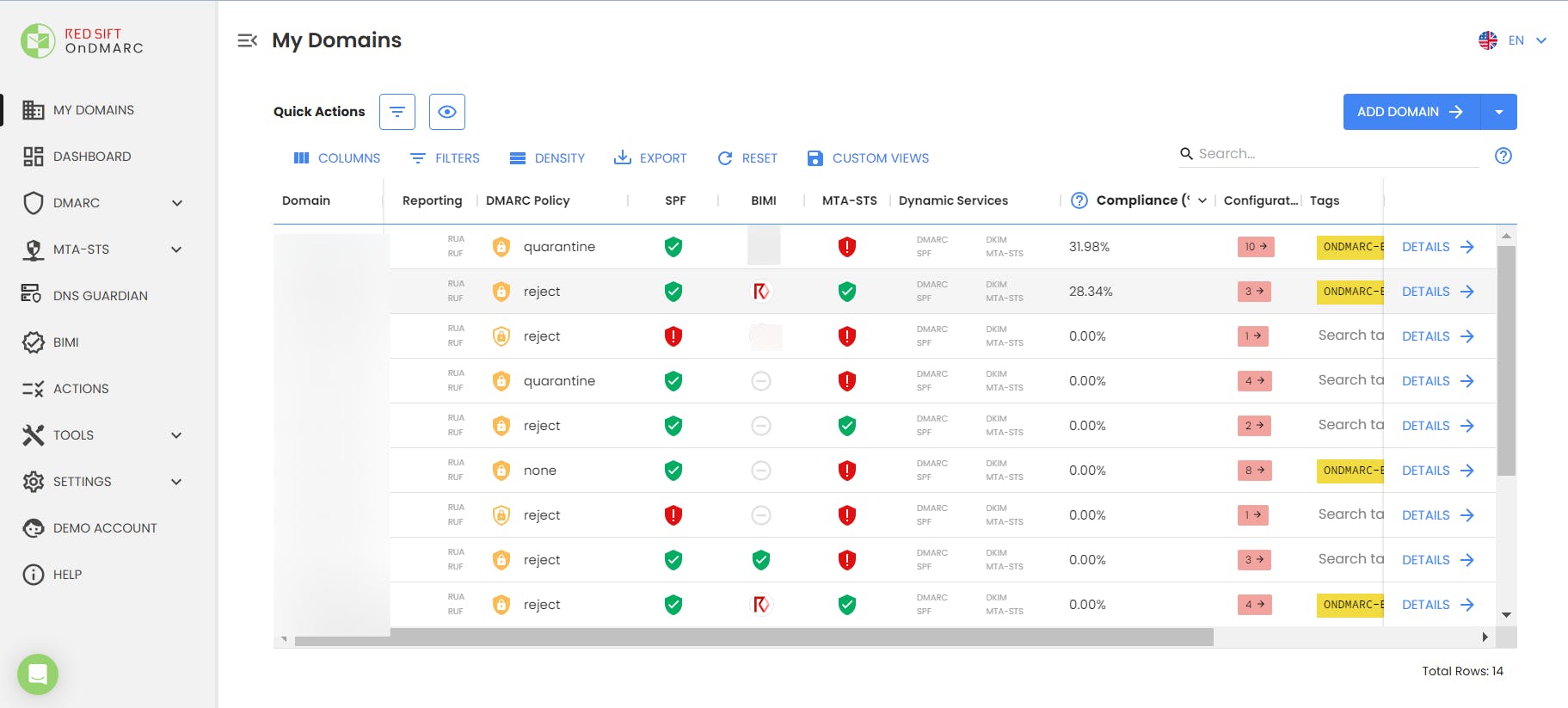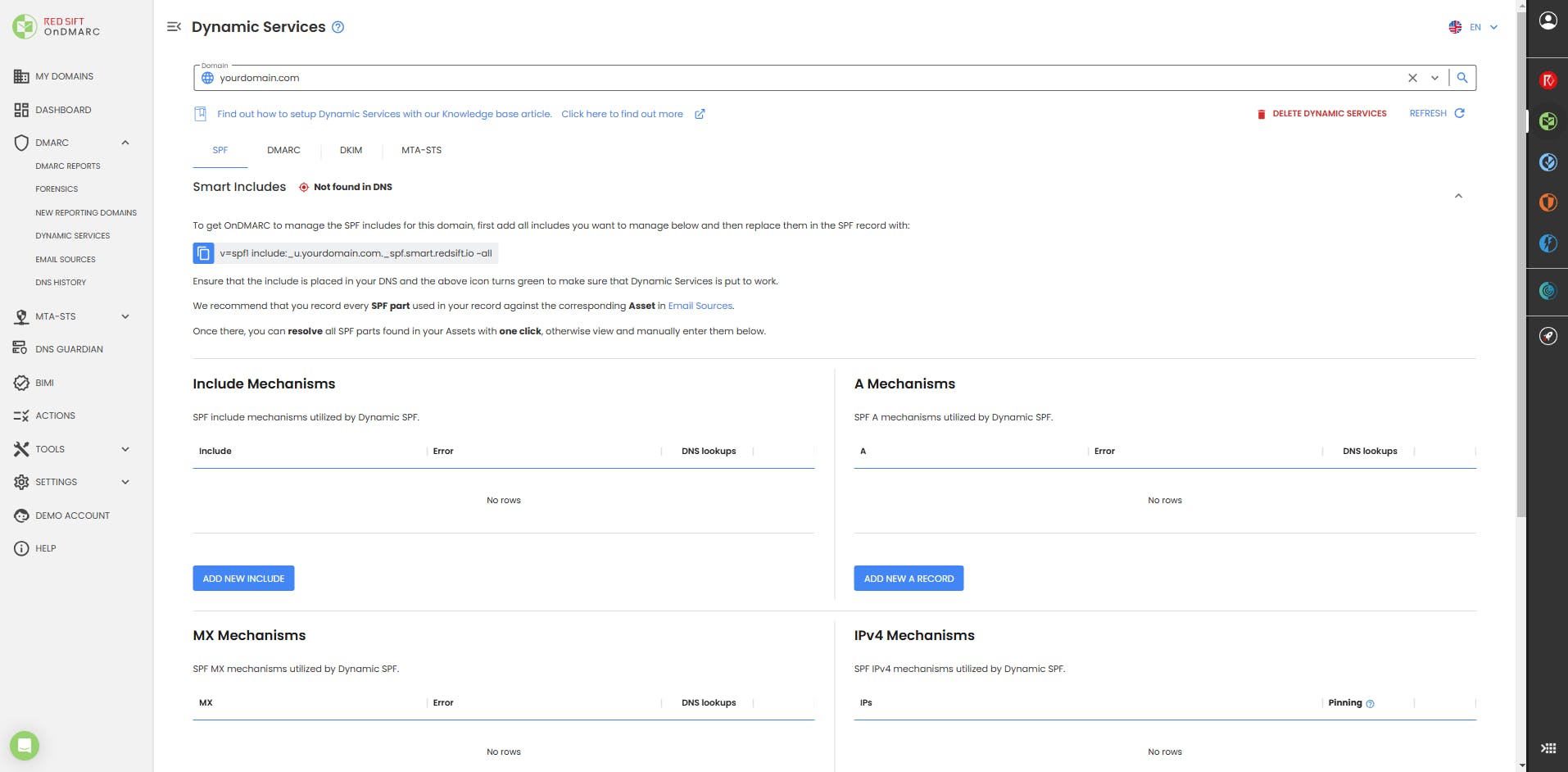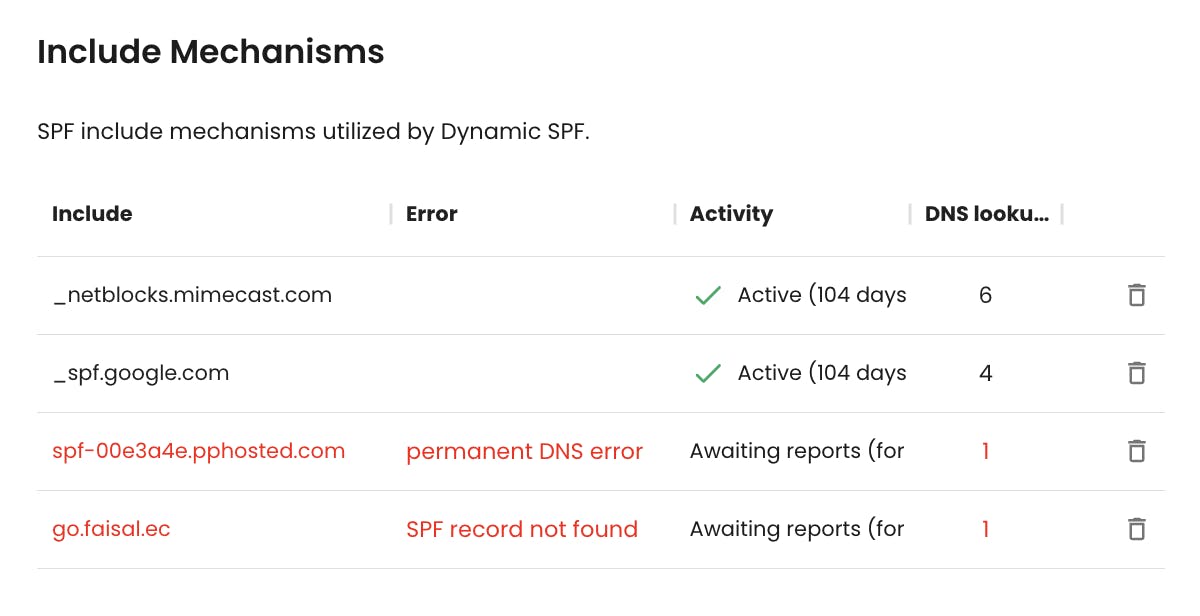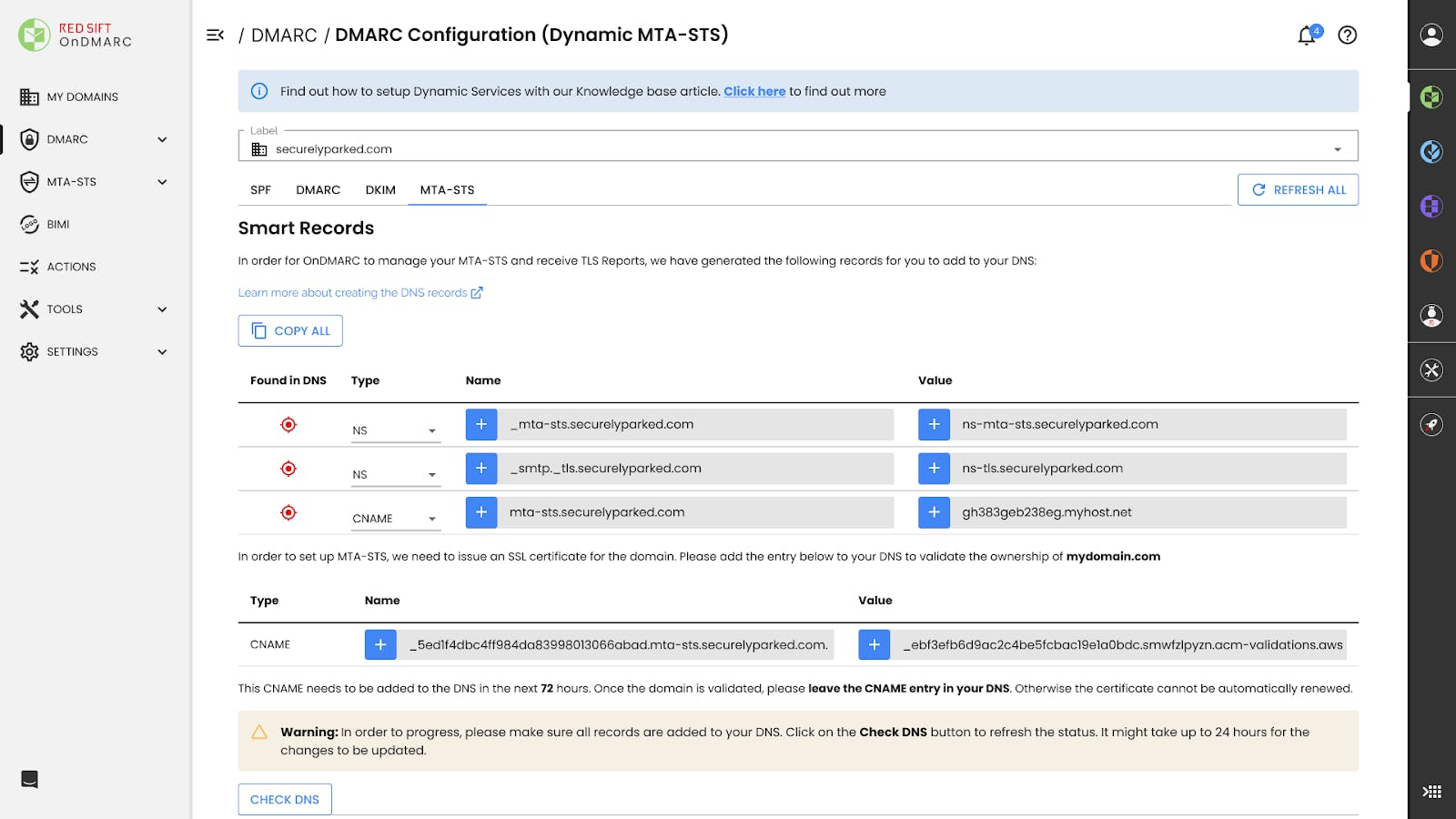Last updated: July 2025
Looking for a PowerDMARC alternative that enables you to rapidly and confidently take control of email authentication? Red Sift OnDMARC is built to help organizations detect and stop unauthorized use of their domains—efficiently and safely. Here's how the two products compare.
Red Sift OnDMARC overview
Red Sift OnDMARC is a cloud-native solution that automates and simplifies the process of deploying and maintaining DMARC, SPF, DKIM, and MTA-STS records. The application accelerates projects by eliminating guesswork, guiding users through setup, and enabling fast resolution of configuration issues. On average, organizations reach full enforcement in just 6–8 weeks.
Key differentiators include an integrated BIMI and Verified Mark Certificate (VMC) solution, a built-in LLM assistant for resolving issues, and DNS monitoring capabilities to identify vulnerabilities such as dangling records and subdomain hijacking.
OnDMARC is trusted by major global brands like Capgemini, Domino’s, Wise, and ZoomInfo. In late 2023, Cisco chose OnDMARC as the DMARC provider to power its Cisco Domain Protection offering.
A 14-day free trial with unrestricted feature access is available directly from the Red Sift website.
PowerDMARC overview
PowerDMARC is a cloud-based email security product that helps organizations monitor and configure email authentication standards including DMARC, SPF, DKIM, MTA-STS, TLS-RPT, and BIMI.
It is especially popular among MSPs and MSSPs, offering multi-tenant capabilities and white-labeling options that support reseller models. PowerDMARC’s reach is strongest in the Middle East, where it operates offices in the UAE, Oman, and Qatar.
A 15-day trial is available, however, more advanced features, such as hosted DKIM, MTA-STS, and PowerAlerts, are limited to paid tiers.
The comparison at a glance
While Red Sift OnDMARC and PowerDMARC are both designed to help security teams take control of their email-sending services and protect their domains from exact domain impersonation, their key differences lie in their target audiences, feature sets, speed to enforcement, and wider portfolio.
An overview of Red Sift OnDMARC vs PowerDMARC
Red Sift OnDMARC | PowerDMARC | |
Average time to enforcement | Not disclosed | |
Hosted MTA-STS & TLS-RPT | ✅ | ✅ |
Dynamic SPF | ✅ | ✅ |
Hosted DKIM | ✅ | ✅ |
Hosted BIMI with VMC integration | ✅ | ❌ |
Aggregate & forensic reporting | ✅ | ✅ |
Enhanced forensic data | ✅ | ❌ No enhanced feeds from Yahoo or Abusix |
DNS configuration monitoring | ✅ | ❌ |
Embedded LLM assistant | ✅ | ❌ |
APIs | ✅ | ✅ |
Third-party threat data (e.g. Spamhaus) | ✅ | ❌ |
Investigate tool | ✅ | ✅ |
Customer Success Engineer included at Enterprise level | ✅ | ❌ Optional add-on at Enterprise level |
Let’s get into the nitty-gritty of how these two applications compare 👇
Ease of provisioning
DMARC can be a complicated and error-prone security protocol to understand and implement. This makes effective technology and robust provisioning all the more important.
Red Sift OnDMARC
Getting started
OnDMARC provides a streamlined onboarding experience. Upon activating the free trial, users are guided to the ‘My Domains’ dashboard, which surfaces a clear view of their domain landscape and associated protocol status (DMARC, SPF, MTA-STS, and BIMI).


To begin protection, users follow a short three-step setup process. They can opt for Dynamic Services to manage records via Red Sift’s hosted infrastructure or choose to configure DMARC manually. Dynamic Services eliminates direct DNS editing by generating a small number of smart records, reducing setup friction and human error.
Once records are deployed, DMARC reports begin to flow in, enabling analysis and next steps.
Configuration troubleshooting
OnDMARC’s Investigate tool allows users to test authentication configurations in real time, bypassing the 24-hour delay typically associated with DMARC report propagation. This dramatically accelerates problem resolution and policy deployment.
Investigate is tightly integrated with the Email Sources inventory, enabling users to diagnose issues with SPF and DKIM alignment, view active selectors and mechanisms, and quickly validate changes.
In addition to Investigate’s troubleshooting capabilities for DMARC implementations, it also features a number of Compliance Profiles that you can check your sending services against to make sure they’re compliant with the UK Minimum Cyber Security Standard, US Binding Operational Directive 18-01, or Google, Yahoo and Microsoft’s Bulk Sending requirements.


Inventory of email assets
The Email Sources view provides a continuously updated, categorized inventory of all email-sending services observed per domain. Users can tag each source as legitimate or suspicious, store associated SPF mechanisms and DKIM selectors, and record internal ownership details to support long-term operational continuity.
This feature helps teams avoid duplication of effort and ensures that critical context remains preserved across personnel changes.


PowerDMARC
Getting started
PowerDMARC offers a setup wizard that walks users through the initial configuration steps, including options for forensic data handling. It recommends setting up hosted DMARC records using CNAME redirection, which allows users to manage records from within the interface.


For non-technical users or those lacking direct DNS access, PowerDMARC also integrates with Entri to support automatic DNS publishing through a single click.


A checklist-based interface helps guide configuration completion and overall domain readiness.


Configuration troubleshooting
PowerDMARC includes a diagnostic tool called MailAuth Analyzer. By sending a test message to the analyzer, users can review domain-specific compliance with DMARC, SPF, DKIM, MTA-STS, TLS, and BIMI.
The tool outputs both simplified summaries and raw header data, which is valuable for both technical and non-technical users troubleshooting authentication issues.


Inventory of email assets
PowerDMARC does not automatically generate an inventory of observed email-sending sources. Users must manually identify and manage their services, which can increase operational overhead, especially in larger environments with many domains.
Hosted email records
Red Sift OnDMARC
Standard DNS implementations of SPF, DKIM, DMARC, and MTA-STS all suffer from the same problems - they are difficult to edit and error-prone, especially if you control multiple domains across multiple registrars.
Red Sift OnDMARC’s Dynamic Services solves this problem by allowing its users to control all of their records from within the OnDMARC app, avoiding the need to go into the DNS whenever updates need to be made to records. This is done by replacing the static DNS records with OnDMARC's smart records, either via NS delegation for DKIM and DMARC or a new smart TXT record for SPF.
Dynamic Services allows users to add additional SPF mechanisms, change their DMARC policy, or host 2048-bit DKIM keys that some DNS hosts do not support.
PowerDMARC
PowerDMARC enables hosted record management for SPF, DKIM, DMARC, and MTA-STS and integrates with Entri to enable 1-click provisioning. This integration is particularly valuable for users who may not have direct access to DNS settings—such as marketing teams, MSPs, or organizations with siloed IT responsibilities—because it removes the need to coordinate with DNS administrators for every configuration change. By automating DNS record updates, Entri helps reduce setup friction, speeds up deployment, and lowers the risk of human error.
Hosted SPF
Red Sift OnDMARC
Red Sift’s Dynamic Services allow users to manage all key authentication records (SPF, DKIM, DMARC, and MTA-STS) from within the product. Once smart records are deployed via NS delegation or TXT override, future changes no longer require DNS access.
For SPF, Dynamic SPF flattens and compacts authorized services into a single include, bypassing the 10-lookup limit without relying on macros, which are incompatible with many legacy systems.


Dynamic SPF also makes it easy to clean up or remove unused or redundant mechanisms that are no longer necessary or needed. As shown in the Activity column above, OnDMARC tracks if a mechanism is active or not based on the info found in DMARC reports.


PowerDMARC
PowerDMARC has a macro-based SPF solution called PowerSPF. Although macros are widely used, they are not always supported by legacy email infrastructure. When an email goes to an unsupported receiver, the entire authentication fails causing catastrophic deliverability issues. According to an academic study on SPF, around 25% of SMTP servers fail to properly expand SPF macros.
Hosted MTA-STS and TLS reporting
Mail Transfer Agent Strict Transport Security (MTA-STS) ensures the secure transmission of emails over an encrypted SMTP connection and stops man-in-the-middle (MITM) attacks.
Red Sift OnDMARC
OnDMARC offers hosted MTA-STS as part of Dynamic Services, handling policy hosting, certificate management, and reporting. TLS violations are flagged automatically, giving security teams a clear view into attempted downgrades and encryption failures.


PowerDMARC
MTA-STS and TLS-RPT are available within PowerDMARC, but these are considered premium features and not included in the free tier.
BIMI
Brand Indicators for Message Identification (BIMI) lets organizations display their brand logo next to every DMARC-authenticated email they send. Studies have shown that BIMI can improve open rates by 39% and increase brand recall by 44%.
Red Sift OnDMARC
Red Sift OnDMARC’s BIMI feature is the only integrated BIMI and Verified Mark Certificate (VMC) solution available on the market. It helps users take care of their BIMI application end to end, including the obtainment of a VMC or CMC without having to go directly to the Certificate Authority (CA).
Red Sift OnDMARC has a direct integration with DigiCert, the CA that issues VMCs. Application data is transferred between Red Sift and DigiCert via API and once processed, Red Sift issues the VMC and gets the customer BIMI-ready.
Red Sift OnDMARC is the only DMARC solution using DigiCert’s API.
Another advantage of using OnDMARC’s BIMI feature is that a free VMC license is included in its Enterprise tier so organizations don’t need to secure additional budget for BIMI.
PowerDMARC
PowerDMARC offers a hosted BIMI option where users can upload SVG logos and optional VMC certificates. However, it does not provide integrated VMC provisioning, and users must apply directly to a certificate authority.
DNS configuration monitoring
Traditionally DMARC products focus on email authentication and do not include DNS configuration monitoring. However, given the rise in SubdoMailing attacks - where attackers exploit misconfigured or deprovisioned subdomains to send “authenticated” spam - vendors offering this functionality provide a crucial and innovative layer of security.
Red Sift OnDMARC
Red Sift’s DNS Guardian actively monitors for DNS misconfigurations and domain takeovers, identifying SubdoMailing attempts, dangling DNS records, and CNAME hijacking. This is made possible through Red Sift ASM’s asset intelligence and DNS expertise—providing visibility no other DMARC vendor currently offers.
PowerDMARC
While PowerDMARC recognizes the risks associated with DNS misconfigurations, it does not currently offer a monitoring feature to detect dangling records or SubdoMailing attempts. A historical DNS timeline is available but lacks real-time security functionality.
Embedded LLM assistant
LLMs and AI assistants like GPT-4 offer immense value by providing quick answers and troubleshooting help. However, for security teams, the challenge lies in the fact that these tools often aren’t embedded within their existing workflows or trained on cybersecurity-specific intelligence, limiting their accuracy and reliability in this context. So, when vendors integrate this cutting-edge technology into security workflows, it becomes a significant value add, saving time and streamlining workflows.
Red Sift OnDMARC
Red Sift OnDMARC includes Radar, an upskilled LLM assistant trained on rich email and domain intelligence, embedded directly into the product. It identifies misconfigurations, flags errors, and offers actionable insights across the email authentication stack. Radar supports faster progress to full DMARC enforcement and simplifies issue triage for less technical users.


PowerDMARC
At the time of publication, PowerDMARC does not offer an LLM or an AI assistant.
Alerting and notifications
Strong alerting capabilities allow organizations to quickly respond to potential threats, minimizing the impact of phishing and other malicious activities.
Red Sift OnDMARC
OnDMARC’s Notifications feature lets you set up daily or weekly Compliance reports, Action Reminders, and Configuration Alerts to an email or Slack channel of your preference.
The reports and alerts include:
- Compliance Reports - round up the volume of passed, quarantined and rejected mail for the domains specified in the report
- Actions Reminders - a list of outstanding actions for the domains specified in the report
- Configuration Alerts - these include senders with a bad reputation sending on behalf of your domain, known services sending on behalf of your domain, and if an asset’s compliance level drops off significantly (indicating a configuration problem)
PowerDMARC
PowerDMARC offers flexible alerting and granular role-based access control, including alerts for DNS changes and threshold-based notifications. However, these advanced alerting options are only available in premium plans.
Customer Success
A key factor to consider in any DMARC project is the time needed to achieve full protection quickly and safely. With cyberattacks becoming increasingly sophisticated, speed and expertise are critical. A well-trained Customer Success team can significantly accelerate progress toward enforcement while minimizing risks.
Red Sift OnDMARC
OnDMARC includes access to a dedicated Customer Success Engineering (CSE) team at the Enterprise level. These engineers specialize in authentication protocols and work closely with customers to guide them through complex implementations.
With strong customer satisfaction scores (NPS 62, CSAT 88), the team has earned high praise from customers including Capgemini, ZoomInfo, TalkTalk, and Holland & Barrett.
In addition, Red Sift OnDMARC is consistently named a DMARC leader by G2 and was even named Europe and EMEA's #1 DMARC vendor for Spring and Summer 2025.
PowerDMARC
PowerDMARC offers a standard DMARC Deployment Service free of charge until a reject policy is achieved. For more comprehensive support, Extended Support plans are available, providing 24/7 technical access and a dedicated account manager.
User feedback for PowerDMARC’s support team is generally positive.
Integrating with your stack: APIs and integrations
Red Sift OnDMARC
OnDMARC has a REST API that can be used to integrate with custom dashboards and other internal systems. All endpoints are documented here with working examples. Capabilities include managing Dynamic Services, creating customer charts from reporting data, adding and removing domains, configuring alerts, or analyzing any domain programmatically.
PowerDMARC
PowerDMARC offers a comprehensive set of APIs, with robust documentation available to support integration into external systems and workflows. These APIs are particularly useful for MSPs and enterprises managing multiple tenants or domains, allowing for automation of tasks such as domain onboarding, policy updates, and report retrieval. While API access may require a paid tier, the available documentation is publicly accessible, enabling teams to evaluate integration options in advance.
Sharing email intelligence with other tools
Red Sift OnDMARC
Red Sift OnDMARC has access to a Spamhaus data feed that flags bad actors as well as legitimate sources that may be getting flagged and causing deliverability issues. It also has an integration with Validity whose data feeds enhance Red Sift’s ability to monitor brand spoofing and phishing for customer domains as they relate to DMARC.
Red Sift is one of only two DMARC vendors that have access to the Yahoo forensics feed, which enhances forensic reporting. In addition, Red Sift OnDMARC has a unique integration with Abusix which further enhances forensics.
In Summer 2025, Red Sift launched its Event Hub that allows teams to pipe real-time, structured security events from Red Sift products into the platforms they already use: SIEMs, SOARs, XDRs, ticketing tools, messaging platforms, and cloud storage.
Red Sift OnDMARC is one of four interoperable products on the Red Sift Pulse Platform. OnDMARC and Brand Trust, Red Sift’s lookalike domain discovery application, sync to automatically add your domain assets into Brand Trust and then start looking for similar domains that may be impersonating your brand.
PowerDMARC
PowerDMARC is a standalone DMARC product.
It does not have data feeds to enhance its forensic reporting capabilities. It also does not offer SIEM integrations.
So, which one to choose?
Both Red Sift OnDMARC and PowerDMARC offer robust, full-featured solutions for managing email authentication protocols like DMARC, SPF, DKIM, and MTA-STS. Each product supports hosted record management, automation, real-time troubleshooting, and strong API integrations—making either a solid choice for organizations looking to improve their domain security posture.
The decision ultimately comes down to which approach aligns best with your team’s needs. PowerDMARC offers strong multi-tenancy and white-labeling capabilities, making it well-suited to MSPs and service providers, particularly those with operations in the Middle East.
Red Sift OnDMARC, on the other hand, leans into streamlined usability, deep integrations across the broader Red Sift ecosystem, and features like embedded AI assistance and DNS risk monitoring that go beyond email authentication. For teams looking to move fast, scale intelligently, and reduce manual effort without compromising control, Red Sift may offer the edge.
Learn more about Red Sift OnDMARC





